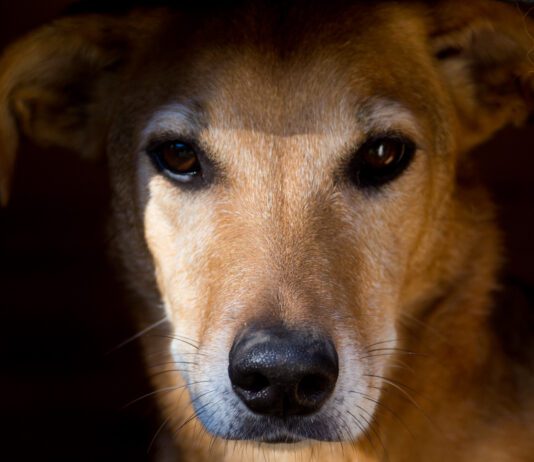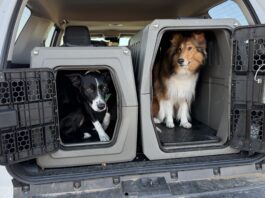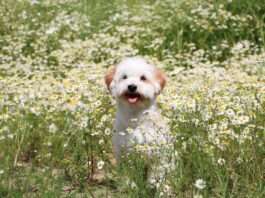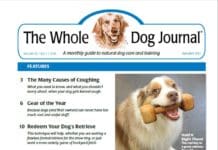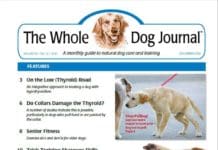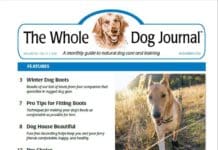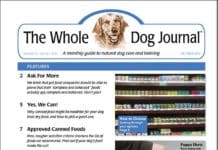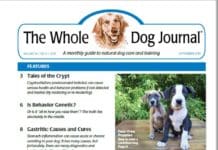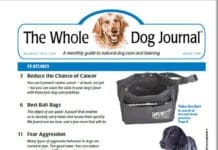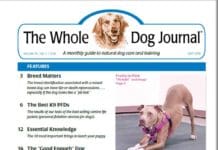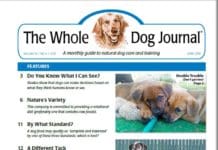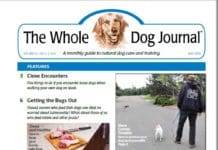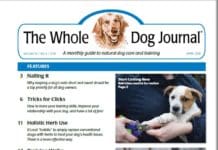Download the Full January 2017 Issue PDF
Whole Dog Journal's mission is to provide dog guardians with in-depth information on effective holistic healthcare methods and successful nonviolent training. The methods we discuss will endeavor to do no harm to dogs; we do not advocate perpetrating even minor transgressions in the name of "greater good." We intend our articles to enable readers to immediately apply training and healthcare techniques to their own dogs with visible and enjoyable success. All topics should contribute to improving the dog's health and vitality, and deepening the canine/human bond. Above all, we wish to contribute information that will enable consumers to make kind, healthy, and informed decisions about caring for their own dogs.
Download the Full December 2016 Issue PDF
A warning growl is a dog's cry for help. It's your dog's way of telling you he can't tolerate a situation - as if he's saying, "I can't handle this, please get me out of here!" Instead of making things worse, heed the warning. Help your dog out of the situation that's causing him discomfort, and take behavior modification steps to help him become more comfortable with the stressor.
Download the Full November 2016 Issue PDF
Plants were the original pharmacy for humans and animals, and over thousands of years, cultures around the world developed remedies that remain in use today. Herbal teas, tinctures, capsules, poultices, rinses, and massage oils are widely sold. American consumers spent nearly $7 billion on herbal products in 2015, which is $480 million more than we spent on them in 2014, marking the 12th consecutive year of growth. The medicinal herbs industry is thriving.
Download the Full October 2016 Issue PDF
Fed in appropriate amounts, canned food is a very healthy choice for dogs. Its moisture content is far closer to that of so-called evolutionary diets for dogs, the sort of food dogs ate before they came to rely on us to feed them. Good-quality canned foods generally contain far more meat than dry foods; meat, the most natural canine ancestral diet ingredient, often accounts for as much as 95 percent of a good canned food! And meat is incorporated into canned foods in a much less processed form than the meat used in most dry foods. In top-quality canned dog foods, real, fresh meats from named species are the rule, not the exception. That's awesome!
Download the Full September 2016 Issue PDF
Nobody like subjecting her dog to surgery - especially for a second time, as was the case with my dog! And there's always the occasional piece of anecdotal evidence suggesting that dogs with cryptorchidism can live to a ripe old age without surgical intervention or complications. For me, however, the combination of my vet's recommendation to re-neuter Saber by age four, the gnawing fear of cancer, and some unwanted, hormonally driven behavior (insatiable sniffing), solidified my decision to pursue the second surgery - which was successful. (And, I'm pleased to report the excess sniffing stopped almost immediately; I wouldn't have believed it could happen so quickly, had I not witnessed the remarkable change.)
Download the Full August 2016 Issue PDF
Regular exercise helps reduce stress, another lifestyle factor in the development of cancer. Uncontrolled stress has been shown to exacerbate tumor growth in humans. Signs of stress in your dog vary from obvious (digestive upset or lack of appetite) to subtle (persistent licking with no other cause, yawning, scratching for no obvious reason, dropped tail, drooling, low/back ears). Feed a good-quality food in appropriate amounts to keep your dog fit and slender. Be sure your dog gets plenty of exercise, and address stress issues by incorporating the help of a trainer or your veterinarian to isolate and eliminate the source.
Download the Full July 2016 Issue PDF
Prior to the development of DNA testing, the only method available for identifying the breed of a dog whose heritage was unknown was visual assessment. A shelter worker, veterinarian, or animal control officer examines the dog and assigns a breed designation based upon physical appearance and conformation. Even with widespread availability of DNA tests, most shelters and rescue groups continue to rely upon visual identification to assign breed labels to the dogs in their care. Given the life or death import of these decisions for some dogs, it is odd that the question of the reliability of these evaluations has not been questioned.
Download the Full June 2016 Issue PDF
Without a doubt, gaze and eye contact are highly important to dogs. They use eye contact in various forms to communicate with us and with other animals. We know that many dogs naturally follow our gaze to distant objects (i.e., as a form of pointing) and that dogs will seek our eye contact when looking for a bit of help. And now we know that dogs, like humans and several other social species, can be aware of what a person may or may not be able to see and, on some level, are capable of taking that person's perspective into consideration.
Download the Full May 2016 Issue PDF
Being approached by loose dogs, especially when my dogs are on leash, is my least-favorite experience as a dog owner. When we're walking in a public place, such as a beach or park, I can usually identify the owner and ask that he please wrangle his dog. Of course, this request may be met with varying responses, ranging from appropriately apologetic for their dog having invaded our space, to accusatory, suggesting I am the problem for not allowing my dogs to roam free and socialize. But as uncomfortable as it may be to deal with unpleasant dog owners, it can be even worse to deal with a loose dog whose owner is nowhere in sight!
Download the Full April 2016 Issue PDF
[IMGCAP(1)]…


